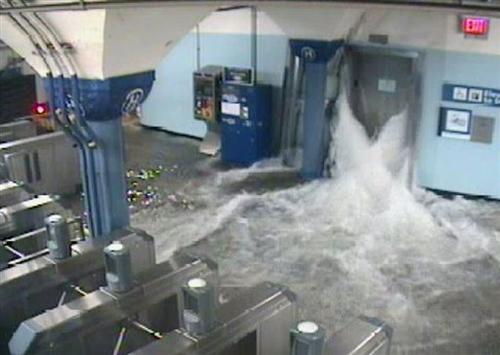Infrastructure protectionInnovative ideas for protecting NYC, NJ from storm surges
One proposal in the U.S. Department of Housing and Urban Development (HUD) Rebuild By Designcompetition to develop innovative ways to protect against Hurricane Sandy-like disasters calls for a string of artificial islands off the coast of New Jersey and New York to reduce the impact of future storm surges.Other proposals include building sea walls around cities along the coast, reestablishing oyster colonies in tidal flats to limit wave action, and creating water-absorbent nature and recreational preserves.

Hoboken PATH station flooded from Sandy's storm surge // Source: syr.edu
As part of the U.S. Department of Housing and Urban Development (HUD) Rebuild By Design competition to develop innovative ways to protect against Hurricane Sandy-like disasters, Alan Blumberg, a professor at Stevens Institute of Technology, has proposed a string of artificial islands off the coast of New Jersey and New York to reduce the impact of future storm surges.
“We’ve discussed this with the governor’s office of Recovery and Resiliency and the Department of Environmental Protection, and they all look at me like, ‘Whoa! This is a big deal!” said Blumberg. “Yes, it is a big deal. It can save lives and protect property.”
At about $10 billion, the proposal, titled “Blue Dunes,” is one of ten projects that will be evaluated and voted on next week by federal and state officials. The Wichita Eagle reports that other proposals include building sea walls around cities along the coast, reestablishing oyster colonies in tidal flats to limit wave action, and creating water-absorbent nature and recreational preserves. Though none of the proposals is guaranteed to receive funding, a winning project could be funded in part by the $60 billion Sandy aid package Congress passed in 2013, along with funds from disaster recovery grants, and other public-private sector resources.
“How do you protect New Jersey and New York at the same time from the storm of the future?” Blumberg asked. “Our idea is to build a chain of islands, like a long slender banana. The wave action and storm surge will reflect off these islands and go back out to sea rather than hitting the coast. Barnegat Bay would not be pounded, nor would lower Manhattan or Hoboken.” The islands, ten miles off the coast, would be built by filling sand atop a hard base made of rock, concrete, or other materials. A gap would be left between the New York and New Jersey island groups to allow water from the Hudson River to reach the Ocean. Blumberg notes that the islands would be uninhabited but recreational activities like surfing and fishing may be permitted.
Blumberg’s proposal would require cooperation between multiple government agencies according to Stewart Farrell, head of Stockton College’s Coastal Research Center. “The sand borrow sites always run into strong objections from the U.S. Fish & Wildlife Service: ‘Something MIGHT live there,’” he said. “Next in line would be the historical preservationists: You can’t cover up Captain Kidd’s treasure ships, no way! And every 19th-century coal barge is an historical treasure. Then there are abundant submarine cables, lines, pipes and rights of way.”
While Blumberg’s proposal is focused on reducing the impact of storm surges, it does not address rising sea levels or flooding. George Kasimos, founder of Stop Fema Now, a grassroots campaign against higher flood insurance rates, welcomes the Rebuild By Design competition, but believes money would be better spent on building or strengthening dunes along the existing shoreline. “Anything to help protect our coast,” he said. “All we need to do is build a proper dunes system, sea gates and sea walls. It seems like $10 billion to build something 12 miles out is overkill. Typical government overkill.”
Blumberg agrees that a rise in sea level is a major concern, but a new approach to protection is needed. “This is innovative thinking,” he said. “It’s 2014; it’s time to think differently.”
